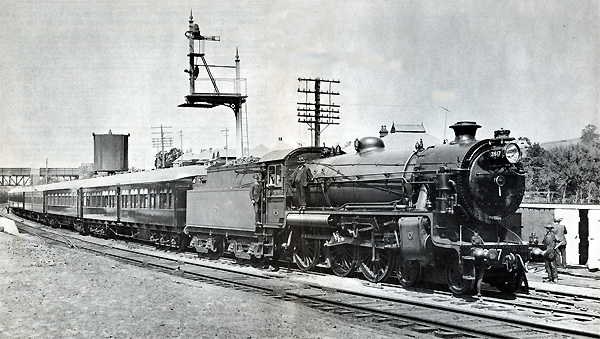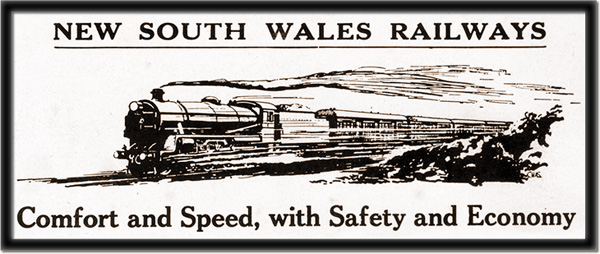|
|
|
|
|
| |

|
Express
Passenger Locomotive 3642
— entered
service in 1926 - now undergoing a light mechanical overhaul
|
|
| |
The 36 Class
Origins & Development
The 36 Class of steam locomotives was a relatively minor development of the 35 Class express passenger locomotive (introduced in 1914 as the NN Class - later designated as the 35 Class).
The design was therefore a development of the British-inspired narrow-firebox 4-6-0 type, following the successful P (later 32) Class, the not so successful N (later 34) Class, and the 35 Class. The design continued the large (5' 9") driving wheels of the 35 Class, but with only slightly greater tractive effort.
The major areas of improvement were the outside Walschaerts valve gear - much easier to service and maintain, an improved ash pan design, a self-cleaning smokebox and a much larger tender, of the 'turret' type; this was the first application of a 'turret' type tender on the NSWGR.
Ten of the class (Nos. 3601 to 3610) were built by the NSW Railway Workshops at Eveleigh, the remaining 65, including 3642, by Clyde Engineering.
As superheating had, by 1923, been firmly established as an essential design parameter for main-line locomotives, the whole class of 75 locomotives were superheated from the outset. In a departure from the practice established by the-then CME William Thow with his P Class express passenger locomotive in 1892, the 36 Class in original form had a round-top boiler rather than the Belpaire type. In the early to mid-1950s, the majority of the 36 Class locomotives were rebuilt with new, all-steel Belpaire boilers and re-designed cabs.
The design was a response to the increased loading of express trains and public demand for shorter journey times, as well as to the need for reduced servicing and lower maintenance costs. The addition to the fleet of a substantial number of large express passenger locomotives with higher availability, enabled older classes to be retired or relegated to lesser trains.
Typical of the technology of the day, the riveted steel boilers originally fitted to the class had copper inner fireboxes, fire-tubes and superheater flues. The replacement Belpaire boilers fitted in the 1950s had steel fireboxes, tubes and flues, in line with US practice and later NSWGR policy. This change was no doubt based on considerations of cost and longevity, as although copper provides superior heat transfer, it promotes a galvanic reaction resulting in the 'wasting' by corrosion of some steel boiler components such as crown stays and front tubeplates.
A noteworthy feature of the class was their outside Walschaerts valve gear, by then well-established in Britain and Australia and valued for its ease of lubrication and maintenance. The 36 Class was the first mainline locomotive design in NSW to be so fitted, and all subsequent steam classes continued the trend.
|

Walschaerts steam locomotive
valve gear in operation on a US locomotive.
3642's centre driving wheels
are spoked and not of the Boxpok style as shown here.
Animation used by courtesy of its author, Robert A. Booty.
|
The class were fitted with plate frames, as had been standard British practice at the time, although the shortcomings of this technology had already been recognised in the NSWGR. In common with other NSWGR classes with plate frames, the 36 Class suffered to some degree from frame cracking, and most members of the class needed frame repairs at some stage.
As left-hand-drive had been the standard on the NSWGR since the introduction of the P Class express loco in 1892, the 36 Class was therefore so fitted, with screw reversing gear as per standard British practice. All were fitted with Westinghouse air brake equipment and both engine and tender handbrakes. Originally, all of the class were fitted with 'Detroit' hydrostatic lubricators, typical of the period. |
The 36 Class in Service
Once 'run-in,' 36 Class locomotives were placed in express passenger service, initially on the premier Sydney-Newcastle trains, then later on Southern and Northern expresses and mail trains. The much-increased range of the class was trialled early on, with through trips from Sydney to Albury, a distance of some 400 miles, without changing the engine. By the late 1920s, 36 Class engines were in regular use on the Melbourne Limited and Melbourne Express, generally with only four servicing stops en-route.

Locomotive 3617 standing at Picton with the Royal Train in 1927 |
As the NSWGR's latest and finest, several 36 Class locomotives were used in 1927 to haul the Royal Tour train during the visit of the Duke and Duchess of York when they came to Australia to open the new Parliament House in Canberra. Later that year, the class was used on the first Broken Hill expresses (though not all the way) following the opening of the line through to the 'Silver City.'
On the Main North, 36 Class engines worked trains as far as Armidale, and on the North Coast, to South Grafton. Following the opening of the bridge over the Clarence River at Grafton, the class worked all the way to South Brisbane. By the late 1930s, the 36 Class had displaced the 35 Class on most expresses, including on the Western line - and on prestige trains such as the Caves Express and The Fish, as well as on mail and express trains generally. When the Riverina Express and the Northern Tablelands Express were introduced in 1941, the 36 Class was naturally rostered. Even after the introduction of the more powerful 38 Class in 1943, 36 Class locomotives were still used on the Newcastle Express, until c.1945 when enough 38s had entered service to cope with the traffic. However by the 1950s, the 38 Class had taken over all major expresses, and the 36 Class were generally used on slower passenger services and mail trains, including to Albury, Narrandera, Dubbo, Parkes, Thirroul, Armidale and South Brisbane and local stopping trains on the 'Short North' to Newcastle. On all the lengthy runs to the extremities of the system, the engines were 'relayed' at specific locations.
|

During the 1920s and 30s, the 36 Class was the pride of the passenger locomotive fleet
and featured prominently in much of the Railways' advertising. |
Following electrification of the Western line to Lithgow in 1957, 36 Class locomotives were based at Lithgow, Bathurst and Parkes, and with the introduction of diesel-electric locomotives, were beginning to be used on goods trains as the diesels took over the more important passenger trains. As well as providing a faster service, useful for more perishable goods, the rostering of the 36 Class on freight workings allowed the withdrawal of numbers of Standard Goods locomotives. By the 1960s, withdrawal of the 36 Class (along with other steam loco classes) had begun as more diesels became available, but a number were temporarily returned to traffic in late 1966, to work wheat trains after a record harvest.
Credit: Presented above are slightly modified extracts from a detailed article, 'Meet the Exhibits - Locomotive 3642' by Peter Berriman & Ray Love, which appeared in the NSWRTM's journal Roundhouse, May 2007. For a continuation of the article, see History of Locomotive 3642.
|
|
|






